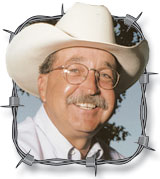This past summer’s drought has created a multitude of problems for farmers in my part of the world; failed crops, short hay supplies, disappearing pastures, dry ponds and a host of other problems that would only cause greater depression if I tried to list them all.
I guess that’s why I wasn’t too surprised when one of my neighbors stopped in, just at dark, a few weeks ago to make me aware that I had some calves out and they were on the county road up by my mailbox. I thanked him for the “heads up” and drove up to the entrance to my farm to see if they were mine and to get them back in the pasture if they were. Sure enough, there were three big feeder calves with my brand on their butt, grazing contentedly on the right-of-way of our little county road.
You see, I have a concrete cattleguard at the entrance to my place so I don’t have to get out and open a gate every time I go in and out of the place. It usually is very effective at keeping my livestock in except when there is drifting snow or, in this case, not many groceries available on the inside. I can’t say as I blamed the calves, for the roadside at least had some green-tinted foliage which had to look better to them than the short, brown stubble in my field. I headed them back to the cattleguard and they jumped back in to find their mothers. I had hoped this was a one-time deal and they would forget the way out.
The next evening, another neighbor phoned to tell me there were some calves out and they might be mine. Another trip up to the road yielded the same result except this time; there were four of the critters enjoying some “government commodities.” I was sure dreading putting up a gate since I pass over the cattleguard at least a dozen times in an average day. Then, as I am prone to do, I got one of those good ideas!
Several years ago, when I was teaching at some agricultural universities in China, I had noticed that the farmers there grazed their water buffalos (which served as their tractors) on the narrow strips of grass between the road and the rice paddies. When I asked the translator how they kept the beasts from eating the rice or getting in the road, he just pointed to a fellow up ahead leaning on what looked like a bamboo stick. I assumed that he was simply a highway worker, but after observing him a few minutes, I watched one of the buffalos amble too close to the dense crop and reach his nose over toward the lush rice. The worker sprinted over to the animal and whacked his nose with the bamboo stick. The animal didn’t jump, run, or even act concerned, but immediately started grazing the grass on the roadside. The worker returned to his post, overseeing that animal and five others evenly distributed over a hundred-yard stretch of road. Perfect conditioning of behavior! I was impressed.
So, knowing that animals COULD be conditioned to stay off the road and eat only from the area prescribed for eating, I decided to put my plan into action. The next day, I went to town and purchased a few sticks of bamboo from the local landscape shop and that evening, about the time the calves had been crossing the cattleguard, I positioned my wife along the road with her brand new bamboo stick and instructed her on what to do.
We now have one of the neatest looking roadsides in the county and the calves are outgaining my neighbor’s calves by quite a bit. If you pass by my place anytime soon, please honk and wave at my wife. She gets really bored and lonesome up on the road every evening.
Jerry Crownover is a farmer and former professor of Agriculture Education at Missouri State University. He is a native of Baxter County, Arkansas, and an author and professional speaker. To contact Jerry about his books, or to arrange speaking engagements, you may contact him by calling 1-866-532-1960 or visiting ozarksfn.com and clicking on ‘Contact Us.’







